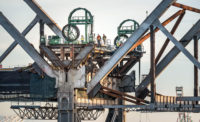Each morning, demolition workers don powered respirators with full hood assemblies, battery packs and air hoses to prevent exposure to the lead paint that covers most of the nearly 80-year-old steel structure of the East Span of the San Francisco-Oakland Bay Bridge.
The team has spent more than 18 months working hundreds of feet above the San Francisco Bay on the $93-million first phase of the multiphase project. Phase one includes removing the 2,420-ft-long cantilevered truss of the double-deck span. In the process, workers not only contend with lead paint, they must cut through stubborn multi-ply steel members and prevent damage to the environment as they disassemble the nearly two-mile-long bridge—flanked to the north by its $6.4-billion self-anchored-suspension replacement.
In addition to removing the cantilevered span, phase one calls for demolishing a temporary bypass structure—built during construction of the new bridge—and completing an eastbound on ramp to the new bridge from Yerba Buena Island—the dividing point between east and west spans. Crews will also remove all traces of construction work from a Coast Guard base on the island, which was disrupted when the bypass was installed.
Unlike for the new bridge, where the California Dept. of Transportation (Caltrans) and the Bay Area Toll Authority tackled problems with broken anchor bolts, water intrusion and a ballooning budget, the demolition project has gone relatively smoothly.
"From a political perspective, the work of the demolition of the cantilevers and the temporary bypass structure has gone according to plan, with the exception of a couple of delays caused by the department," says William Howe, Caltrans' senior resident engineer.
Responsibility for one of the delays, in the fall of 2013, can be placed on Caltrans' efforts to get the new bridge open on time. To put the demo project back on track, Caltrans, in March 2014, approved a $12.67-million change order to allow CEC/Silverado to remove both halves of the cantilever concurrently, rather than one at a time as originally planned.
The plan worked. "In fact, we are ahead of schedule on the demolition of the cantilevers," Howe says. Work on phase one is on course for completion in November.
The cantilevered truss extends 1,400 ft between piers and consists of east and west cantilevered arms with an approximately 500-ft-long suspended span supported in between. In 1936, installation of the suspended span completed construction of the bridge.
Reverse Engineering
"From the inception of the demolition, the idea from the department was that [the bridge] needed to be taken apart essentially in the reverse order that it was built," Howe says. With that guidance, CEC/Silverado retained Foothills Bridge Co. to engineer the dismantling.
Foothills first studied old photographs, historical documents and 1930s-era news articles to understand how the bridge was built, says J Coleman, president of Foothills. "That often ends up being a big contributor to the best way to dismantle a bridge."
Next, Foothills extracted dimensional data—including member sizes, plate thicknesses and rivet diameters—from the original design drawings and created a 3D analysis model. The software allowed the engineer to apply loads, such as wind or heavy equipment, and predict bridge behavior. It also enabled the engineer to virtually dismantle the bridge, piece by piece, to find out which members need to be strengthened to prevent overstress as others are removed.
Checking engineer FBA Inc. verified the final sequence. Caltrans also sent the plan to T.Y. Lin, which acted as a second independent checking engineer.
In addition, Caltrans hired an outside consultant to create a 3D bridge information model (BRIM). All modeled bridge components include data on volume, density and weight.












Post a comment to this article
Report Abusive Comment